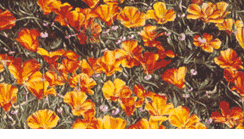|
Memoir America explores our individual historical narratives
and our place within a collective historical narrative. Our
perception of the past is shaped by the language of our time,
the landscape, the rhetoric of messages and images which are
distilled into a personal history and an understanding of
identity. I consider history as memory, continually re-inscribing
itself; as a time capsule discovered and read again and again
and understood only in terms of the present.
The paintings in this series are presented as memory-scapes.
They express my personal view of what it means to be a part
of the American fabric, depicting memories spanning the years
before my birth through the present, roughly from 1965 to
the present. I'm interested in asking how we untangle the
imagery and language of the past in our present.
I see America in terms of the history of the land and an
association with owning, moving through and protecting the
land, a land "made for you and me". Each painting contains
a tangle of landscapes, none being one place but containing
multiple places which influenced my personal narrative. I
see each landscape as an ultra-Americana landscape. Each human
image is grounded in the landscape and a particular time,
in a portrayal and celebration of cultural difference.
The language of the land has been written through the physical
architecture, agriculture, signage and transportation, and
also the written words of song, stories and laws. How we see
this landscape is tied up in the dialog between the physical
and theoretical idea of land. I attempted to have this dialog
on the canvas by integrating text and symbols into our American
landscape. In the painting "Atomic Winter" the texture detail
for the potato cellar, which look like bunkers, are both the
hand written lyrics (second, third and forth stanza) and Morse
code (first stanza) to Francis Scott Keys "Star Spangled Banner",
this is to ask the question of what is the ground we stand
on and how much do we understand the land we come from, much
like how many of us can recognize our national anthem in Morse
code or the other three verses that include the following
lines.
A home and a country should leave us no more!
Their blood has washed out their foul footsteps' pollution.
No refuge could save the hireling and slave.
From the terror of flight, or the gloom of the grave…
As Max Frisch wrote in "I'm Not Stiller" "We live in an
age of reproduction. Most of what makes up our personal picture
of the world we have never seen with our own eyes - or rather,
we've seen it with our own eyes, but not on the spot: our
knowledge comes to us from a distance, we are televiewer,
telehearers, teleknowers." This series is my small addition
to the historical record for all the telegeneration.
Eric Montoya
|






